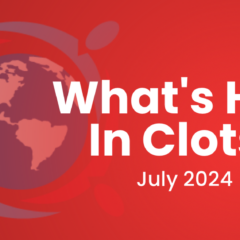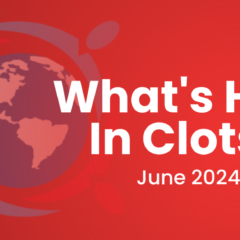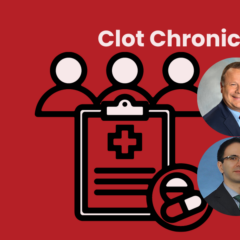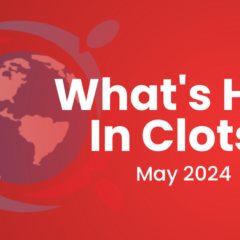Last updated on
Clot Chronicles: CORONA-VTE — Cardiovascular Findings in COVID-19
Hello, everyone. For those of you don’t know me, my name is Aviva Schwartz, and I’m the Director of Content Development at the North American Thrombosis Forum. We’re so pleased to have Dr. Gregory Piazza here with us today. He’s an Associate Professor of Medicine at Harvard Medical School, as well as a Staff Physician and Section Head of Vascular Medicine at Brigham and Women’s Hospital. He’s also NATF’s Education Chair. On this episode of Clot Chronicles, we’ll be discussing CORONA-VTE, which is a COVID-19 study, and Dr. Piazza is the PI. So, thank you so much for being here with us, Dr. Piazza. We’re really thrilled to have you.
Aviva Schwartz: So, early on in this pandemic, arterial and venous thrombosis were observed in COVID-19 patients, and the frequency of these thrombotic events really underscored the need for more research, specifically in the hospitalized population. The CORONA-VTE registry was established within the Mass General Brigham integrated health network back in March. Can you tell us a little bit more about the CORONA-VTE study?
Gregory Piazza, MD, MS: Absolutely. So, really the reason we designed the study was because the practice patterns and the frequency of these complications of COVID-19 that we were seeing out of Asia and Europe didn’t seem like they would represent what we would see in a full pandemic here in the United States. First of all, prophylactic anticoagulation to prevent thrombosis, especially in hospitalized patients, is routine in the US and not routine in Asia.
And for that reason, we might have expected to have more thromboembolic events in an Asian population than we might see here. We really wanted to capture what the practice patterns are in the US and what the real burden of thromboembolic events would be for our COVID-19 population. So, we put this study together, right in March when the US was starting to surge, and were able to get it up and running very quickly.
Schwartz: And what were the primary and secondary outcomes that you were looking for among this population?
Piazza: We wanted to get a sense of what the arterial and venous thromboembolic rates were for patients not just in the ICU but also in the hospitalized, non-ICU setting as well as outpatients. We were also really interested in seeing whether there was going to be an excess of cardiovascular events – not just thromboembolic events like heart attacks and strokes, but looking at other things like atrial fibrillation, myocarditis, and heart failure. And so those were the two key things: arterial and venous thromboembolism and major adverse cardiovascular events.
Schwartz: The results of the study were published in the November 3rd issue of JACC. Why don’t you tell us about the most striking findings that are in that paper?
Piazza: We found a lot of important observations in CORONA-VTE. First of all, something that just has been echoed in a number of studies, is that COVID-19 affects a very broad population in the US. We observed a highly diverse patient population, very variable in their ethnicity and race, and a younger population but also some elderly patients. We observed an interesting spectrum of cardiovascular risk factors, in particular, hypertension, hyperlipidemia, and diabetes. Obesity was also very important.
And as we looked at our populations, we wanted to get a sense of whether there was a difference or a gradation in risk from ICU patients to hospitalized non-ICU patients to outpatients. And so, we were able to actually divide up our population of almost more than 1,100 patients into these little groups. We found that prophylactic anticoagulation was prescribed in almost 90% of patients in the ICU and about 85% of the patients who were in the non-intensive care hospitalized setting.
We observed increased rates of major arterial and venous thromboembolism and major adverse cardiovascular events, especially in that intensive care cohort. Major arterial and venous thromboembolism occurred in about 35% of those patients, and major adverse cardiovascular events actually was as high as almost 46%. In the hospitalized non-intensive care cohort, the rate of major arterial and venous thromboembolism was about 3%, and major adverse cardiovascular events was about 6%.
That’s more than we would expect for the level of thromboprophylaxis that patients were given, so that certainly raises a question of whether the amount or the intensity of thromboprophylaxis that we’re giving is adequate for these patients. Interestingly, we did note that the outpatients seemed to do quite well, as we did not observe the same high rate of major adverse cardiovascular events and thromboembolism in those patients.
Schwartz: You mentioned some of the next priorities for research in terms of the anticoagulation piece, and then we just heard about some of the key comorbidities that were found in these patients. Taken together, what do you think are the key takeaways for clinicians who are taking care of these COVID-19 patients in the hospital, and what are some of the key things that they should know relating to thrombosis?
Piazza: There’s a lot to gain from these types of studies, and luckily there are a lot of them out there. But I think the first thing is to recognize the need for systematic protection for these patients. We know that what we’re doing may not be adequate from an intensity level, but certainly, making sure that every patient that’s vulnerable is at least on some level of protection is the first step towards reducing the burden of these events.
I think recognizing risk factors for patients is very key. There are definitely populations, such as the obese patient population, that need special attention and protection. There are recommendations for adjusting prophylactic dosing of some of our anticoagulants for prevention in the obese population, and care should be extended there. And I think really recognizing that even though this is a younger population—maybe not with as dramatic cardiovascular risk factors as you might expect—there is a risk of arterial and venous thrombosis, and there’s a risk of cardiovascular events.
We have to be on the lookout for those and try to do everything that we can to prevent them, because we don’t know what the long-term complications of all these events will be. We’re hoping that patients recover and get back to normal, but as of yet, we don’t really have data to say that that’s true or not true. Further studies with long-term evaluations will be key.
Schwartz: Well, thank you so much for giving us insight into that very interesting paper. And thank you for joining us on Clot Chronicles.
For all of you who are interested, you can check out the November 3rd issue of JACC to learn more about CORONA-VTE. Thanks, Dr. Piazza.
Piazza: Thanks, Aviva.



